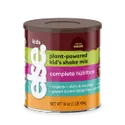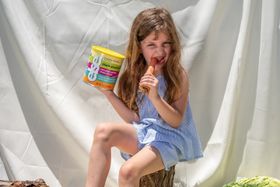High Fiber Foods for Kids: Recommendations and Ideas
Explore recommendations and ideas for incorporating more fiber into your child's diet.
Updated May 15, 2024

Fiber is a critical nutrient for health throughout all of the life stages. It can be especially important for the digestive development of growing toddlers and young children, as well as supporting their overall long-term health. Help make sure your child gets enough fiber by understanding why this nutrient matters and where to find it in fiber rich foods for kids.
What is fiber?
Fiber is an essential nutrient, meaning that your body doesn’t make it and you have to find it in your diet. Fortunately, there are plenty of foods that are natural sources of fiber.
Fiber is actually a type of carbohydrate, but unlike carbs that break down into sugar when eaten, fiber is non-digestible. This is because people don’t have the enzyme needed to do so. Instead of being digested, fiber has several jobs as it passes through the digestive tract. Some of these include cleaning out the intestines and feeding good gut bacteria.
There are two main categories of fiber, soluble and insoluble, each of which have unique activities in the body. Most foods contain both types, but some foods are better sources of one type of fiber than the other.
Soluble fiber dissolves in water and certain types, like beta-glucans, are known to help keep cholesterol and blood sugar levels healthy. Insoluble fiber, on the other hand, doesn’t dissolve in water and is most helpful for moving nutrients and particles and preventing constipation.
Why do toddlers need fiber?
Fiber is essential throughout life. Practicing a high fiber diet for kids is a good habit of starting early on that will have lasting benefits.
Extensive research demonstrates how a diet rich in high-fiber foods supports health outcomes. For instance, people who eat fiber rich food tend to enjoy a lower risk for chronic diseases like type 2 diabetes, heart disease, and cancers.
Studies also suggest that a high-fiber diet may be associated with a lower risk for metabolic syndrome, which is a cluster of symptoms that increase your risk for said chronic diseases. These include things like high blood pressure, abdominal obesity, dyslipidemia, and insulin resistance. While these symptoms are unlikely to affect toddlers, nutrition during childhood can certainly set the stage for health outcomes as kids get older.
A high fiber intake is also correlated with digestive health such as more regular bowel movements , which can be an area of concern for many parents and caregivers of toddlers. Making sure children get enough fiber in their diet helps keep food moving optimally through the digestive system, helping to prevent constipation and support regular stools.
Plus, foods that are naturally rich in fiber also tend to be packaged with other healthy nutrients, like vitamins, minerals, and antioxidants. You can also find rich-in fiber supplements for toddlers, for example Else Nutrition's Plant-Based Complete Nutrition Toddler Drink.
How much fiber do kids need?
While western culture often focuses on getting enough nutrients like protein, it’s fiber that we should really be concerned with.
In fact, while the minimum recommendations for fiber for adults are a mere 30 grams per day, surveys show that 95% of American adults are getting half that amount. What’s even more alarming is that fiber has been deemed a public health “nutrient of concern” in the Dietary Guidelines for Americans 2020-2025. Unfortunately, this isn’t the first time fiber has made that list in the United States.
For toddlers and young children ages 1-8 years old, daily fiber needs fall between 19-25 grams per day. This can be easily met by offering high fiber foods for toddlers multiple times per day.
» Learn more about how to include healthy fats in your little one's diet
Can my child get too much fiber?
While the benefits of fiber are plenty, that doesn’t mean more is always better. As with any food or nutrient there is such a thing as getting too much fiber. For some kids, getting too much fiber can backfire and have unwanted digestive consequences, like constipation, bloating, gas, abdominal pain, soft stools, or other changes in bowel habits.
Increasing dietary fiber intake too quickly can also result in these side effects. This is often attributed to the bulking effects of fiber or its fermentation in the digestive tract. Plus, a child’s gut microbiome can take time to develop. Some ways to reduce dietary fiber intake may include:
- Serving refined white breads and pastas in place of whole grain versions
- Removing the edible skins and peels of fruits and veggies
- Serving 100% fruit juice occasionally in place of whole fruit
- Serving canned veggies
- Avoiding fiber-fortified foods like orange juice with a lot of pulp.
Gradually increasing fiber intake, introducing a variety of plant foods early, and doing so with plenty of water, can help keep these symptoms of too much fiber to a minimum.
15 healthy high fiber foods for kids
Looking for fiber for kids? The only places it’s naturally found are plant foods. This includes fruits and vegetables, grains, nuts, seeds, and legumes, including beans, peas, and lentils. Some plant foods contain more concentrated amounts of fiber than others, so incorporating a wide variety in your child’s diet is the best way to get enough.
Here are 15 healthy and good sources of fiber foods for kids that you can easily offer at regular meals and snack times, including ideas to do so.
15 Rich-in-Fiber Foods
🍏Apples
One medium apple, with its skin on, offers around 5 grams of fiber.
Kids may enjoy apple slices served with a side of almond butter, baked whole in the oven with cinnamon, or blended into smoothies. You can also make apple “nachos”, by arranging thinly sliced apples on a plate and drizzling them with warm peanut butter and a handful of raisins.
🍐Pears
One medium raw pear contains nearly 6 grams of fiber.
Pears are juicy and delicious served raw or cut into slices, halved and roasted or grilled, chopped over ice cream or yogurt, or blended into smoothies.
🫐Berries
There are 8 grams of fiber in one cup of blackberries, 10 grams in one cup of raspberries, 4 grams in one cup of blueberries, and 3 grams in one cup of strawberries.
Berries are a great snack for kids. Plus, they’re incredibly high in vitamin C and other disease-fighting antioxidants. Raspberries fit perfectly on fingertips, sliced strawberries are a delicious topping for pancakes and waffles, blueberries go well with warm oatmeal, and blackberries make tasty smoothies and homemade popsicles.
🍌Bananas
One medium banana contains around 3.5 grams of fiber.
Bananas are often recommended to help soothe upset tummies and provide bulk to loose stools, as they are rich in prebiotics and tend to be easy on the stomach.
They’re nature’s most portable snack, wrapped in their own disposable container. Bananas make a good pancake and waffle topping, can be sliced into thin strips for baby-led weaning, and pair well with peanut butter in a sandwich. You can also make banana splits, topping them with whipped cream and berries.
Use up brown bananas from your countertop to make muffins, or chop them and store them in bags in the freezer for smoothies.
🥑Avocado
One whole avocado contains around 10 grams of fiber, which means just half of one will still contribute 5 grams to your child’s day.
Avocados work well mashed onto toast or crackers, blended into a homemade guacamole, cubed and used as a topping for enchiladas or inside of burritos, or sliced into sandwiches and burgers. Avocado slices can be rolled in breadcrumbs and baked in the oven. You can even add diced avocado to smoothies or homemade ice cream for a neutral-flavored creaminess.
🧡Brussels sprouts
One cup of Brussels sprouts contains around 6 grams of fiber.
While Brussels sprouts can be too tough for younger kids to eat, they soften up nicely in the oven when drizzled with a little olive oil and roasted. For older kids, you can chop them up raw into salads. To reduce the bitterness of Brussels sprouts, slice them in half (or more) and serve them with a dressing, like a balsamic marinade or honey mustard.
🍠Sweet potatoes
One medium sweet potato offers around 4 grams of fiber.
Sweet potatoes can be baked in the oven just like Russet potatoes, and served with a dollop of butter or sprinkled with cinnamon and nutmeg. Roasted sweet potato cubes coated with olive oil and seasonings make a soft, filling side dish. They can even be cooked and mashed with coconut milk for a sweeter version of mashed potatoes. Sweet potatoes can also be cooked and used to make nutritious, tasty blender pancakes like these with Else Nutrition.
🥦Broccoli
One cup of raw broccoli has around 2.5 grams of fiber.
Raw broccoli florets can be served with a side of ranch, hummus, or similar dip your older kids enjoy. You can use broccoli to make homemade veggie tots or savory pancakes, add florets to pastas and casserole dishes, or simply chop and steam it until it achieves a beautiful bright green shade.
💚Lentils
A ½-cup serving of lentils contains nearly 7 grams of fiber.
Lentils can be purchased dry in the bulk section to cook at home, or found in canned form in most supermarkets for convenience.
They can be used to make veggie burgers, lentil loaf, savory salads, soups and dahls, or marinated and served as a side dish.
🫘Beans
All varieties of beans are packed with fiber. You can also find beans dry or canned.
A ½-cup of canned black beans contains 9 grams of fiber, and a ½-cup of canned chickpeas contains 7 grams.
Chickpeas offer a smell and taste similar to chicken, which works well in things like homemade vegan chicken nuggets or chickpea salad sandwiches. They also make a great traditional hummus recipe, and can be blended with nut butter and oats in a food processor to make high-fiber snack balls for kids.
Enjoy black, navy, and white beans in homemade bean dips, soups, salads, casseroles. Black beans can even be added to brownie batter for extra fiber, protein, and other nutrients. Kidney beans work well in burritos, on nachos, or cooked into chili and stews.
🤍Quinoa
One cup of cooked quinoa contains 5 grams of fiber.
Quinoa comes in a number of colors, like red, white, black, and multi-colored. Cooked quinoa makes a great bedding for roasted veggies and tofu, can be rolled into burritos, or can even be used to make a breakfast dish similar to oatmeal.
🌱Seeds
A ¼-cup of chia seeds and flax seeds both offer 10 grams of fiber. You’ll also find 4 grams of fiber in ¼-cup of sesame seeds and 3 grams of fiber in 1 ounce of de-shelled sunflower seeds. While some seeds may still be a choking hazard for young kids, some tiny varieties can be incorporated into recipes or even blended into seed butters.
Chia and ground flax seeds make a perfect vegan egg for baked goods. To make one “egg”, gently combine one tablespoon of chia or ground flax seeds with two tablespoons of water and let the mixture sit for 5 minutes to gel. Then, it can be added to a batter for things like pancakes, waffles, muffins, or desserts as a high-fiber binding agent.
For older kids, you can sprinkle sunflower or sesame seeds onto stir fry meals, roll baked tofu or avocado in sesame seeds, or top salads with just about any seed variety. Seeds can also be added to smoothies for more fiber.
🥣Oats
A ½-cup of raw oats contains 4 grams of fiber.
Oats can of course be used to make oatmeal, blended to make homemade oat flour for baking, used to bulk up homemade veggie burger patties, or added to muffins and pancake batters.
15. Carrots
You can get around 1 gram of fiber from four baby carrots.
Carrot sticks make a great, crunchy snack on their own or served with a dip. Sometimes even cutting carrots (and other vegetable types) into chips with a texture slicer or into matchsticks with a grater can make them even more appealing to kids.
Carrots can be steamed, roasted, cooked and blended into vegan cheese sauces for color, added to stir fries, shredded for sandwiches, or cut into chunks and stirred into soups.
🥜Nut butter
Nuts in their whole form are still a choking hazard for children under age 5, but a good way to serve them is in the form of nut butters. There are plenty of commercial nut butters available, but they can also be made at home by blending raw peanuts, almonds, or cashews in a food processor or high speed blender until smooth.
A 2-tablespoon serving of peanut butter or almond butter both provide around 2 grams of fiber. Cashew butter comes in a little lower at 1 gram of fiber per 2-tablespoon serving.
Add nut butters to smoothies, oatmeals, homemade granola bars, muffin and pancake batters, or use them in sandwiches or spread on tortillas for kids. Or, serve it right off the spoon! For younger kids who may not be ready for the full thickness of nut butter, thin it with a little bit of water and use it as a drizzle instead.
🥕Carrots
You can get around 1 gram of fiber from four baby carrots.
Carrot sticks make a great, crunchy snack on their own or served with a dip. Sometimes even cutting carrots (and other vegetable types) into chips with a texture slicer or into matchsticks with a grater can make them even more appealing to kids.
Carrots can be steamed, roasted, cooked and blended into vegan cheese sauces for color, added to stir fries, shredded for sandwiches, or cut into chunks and stirred into soups.
How to give meals a fiber boost
The best way to increase fiber content in meals and snacks is to add more plant foods to them. These should generally be in the most whole form possible to preserve the most fiber.
For instance, there will be significantly more fiber in a homemade fruit and veggie smoothie than in a store-bought fruit juice. The latter likely has little, if any, fiber in it and is prone to contain other ingredients you may not be seeking, like added sugar.
Some ideas for increasing fiber intake for kids include:
- Replacing meat and poultry with beans, peas, and lentils
- Substituting whole grains, breads, and pastas over ultra-processed white versions
- Choosing whole fruits and veggies over commercial juices
- Offering fresh fruits, veggies, nut and seed butters over crunchy packaged snacks
- Add high fiber fruits and veggies to your favorite Else Nutrition products for a delicious smoothie
If your toddler is experiencing constipation, try adding “P” plant foods to help get things moving. These include pears, peaches, plums and prunes, and may be found fresh, frozen, or canned (just look for ones that are canned in water and not an added sugar syrup). These foods are high in fiber and contain a concentrated amount of natural sugars, which helps draw water from the intestines and into the stool.
Make sure you are monitoring how much fiber your child is receiving and how much your child needs. Make sure you are not overwhelming their system by adding too much. To confirm how much fiber-rich foods your child is consuming check the nutrition labels and compare what they are currently eating to what they need to consume.
Should I give my child a fiber supplement?
A fiber supplement for kids may be appropriate in certain short-term situations, but they shouldn’t be relied upon as a primary source of this nutrient. Fiber supplements don’t contain the other healthy nutrients that food sources offer.
The main reason why fiber supplements for toddlers and young kids are used is to alleviate acute bouts of chronic constipation or diarrhea. Fiber can be used to help promote stool softening and movement, or to help bulk loose stools.
One common fiber supplement is called psyllium husk, which is a soluble fiber sometimes added to things like cereals, breads, and snack bars. When consumed, it forms a sticky gel in the intestines that helps move things through. Another popular fiber supplement is dextrin, which is a soluble fiber derived from corn or wheat that adds bulk to a child’s stools.
Still, high fiber food for kids should be prioritized. Always speak to your healthcare provider before starting a fiber supplement to make sure that the use, type, and dosing regimen is safe and appropriate for your child.
Fiber is essential for your child’s health
Fiber is a critical nutrient for the optimal function and development of your child’s digestive system. Getting enough fiber is also essential for their long-term overall health, as it helps reduce risk for a variety of chronic diseases.
Offering a wide variety of whole plant foods, and adding more fiber-rich ingredients to meals and snacks where needed, are the best ways to help your child meet their fiber requirements.
The content and advice provided in this article is for informational purposes only and is not a substitute for medical diagnosis, treatment, advice for specific medical conditions. Always consult a pediatrician to understand the individual needs of your child.










